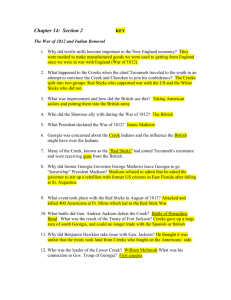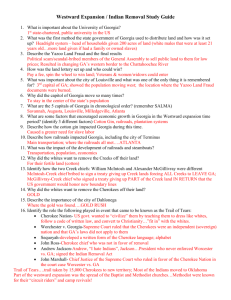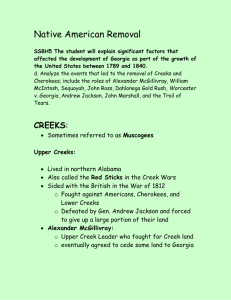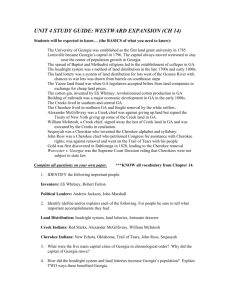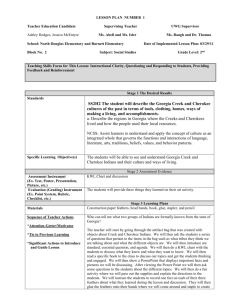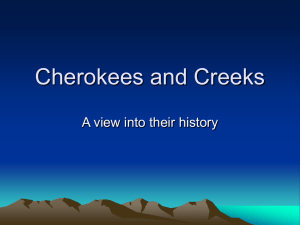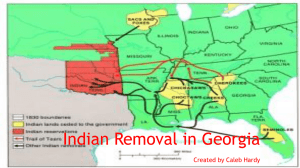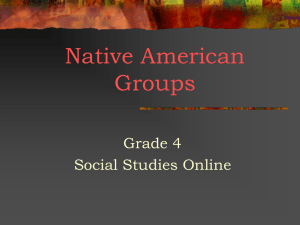Native American Removal outline
advertisement
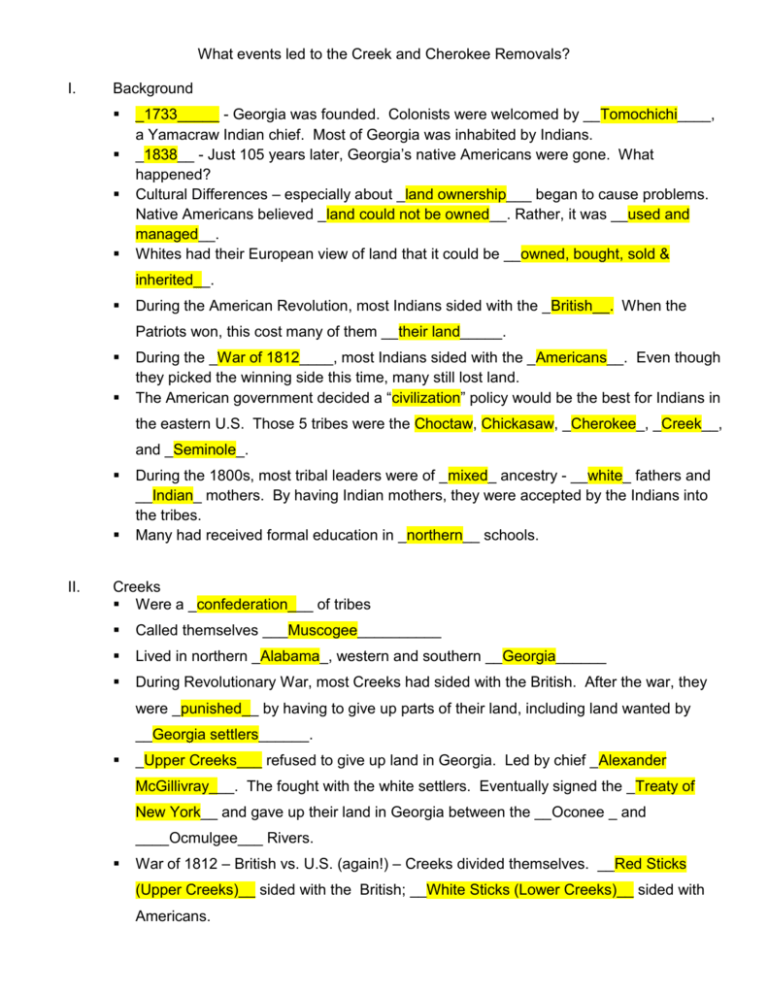
What events led to the Creek and Cherokee Removals? I. Background _1733_____ - Georgia was founded. Colonists were welcomed by __Tomochichi____, a Yamacraw Indian chief. Most of Georgia was inhabited by Indians. _1838__ - Just 105 years later, Georgia’s native Americans were gone. What happened? Cultural Differences – especially about _land ownership___ began to cause problems. Native Americans believed _land could not be owned__. Rather, it was __used and managed__. Whites had their European view of land that it could be __owned, bought, sold & inherited__. During the American Revolution, most Indians sided with the _British__. When the Patriots won, this cost many of them __their land_____. During the _War of 1812____, most Indians sided with the _Americans__. Even though they picked the winning side this time, many still lost land. The American government decided a “civilization” policy would be the best for Indians in the eastern U.S. Those 5 tribes were the Choctaw, Chickasaw, _Cherokee_, _Creek__, and _Seminole_. II. During the 1800s, most tribal leaders were of _mixed_ ancestry - __white_ fathers and __Indian_ mothers. By having Indian mothers, they were accepted by the Indians into the tribes. Many had received formal education in _northern__ schools. Creeks Were a _confederation___ of tribes Called themselves ___Muscogee__________ Lived in northern _Alabama_, western and southern __Georgia______ During Revolutionary War, most Creeks had sided with the British. After the war, they were _punished__ by having to give up parts of their land, including land wanted by __Georgia settlers______. _Upper Creeks___ refused to give up land in Georgia. Led by chief _Alexander McGillivray___. The fought with the white settlers. Eventually signed the _Treaty of New York__ and gave up their land in Georgia between the __Oconee _ and ____Ocmulgee___ Rivers. War of 1812 – British vs. U.S. (again!) – Creeks divided themselves. __Red Sticks (Upper Creeks)__ sided with the British; __White Sticks (Lower Creeks)__ sided with Americans. Gen. __Andrew Jackson___ led the US Army and White Stick Creeks in attacks against Red Sticks and other battles of the war. Most pivotal battle was the Battle of _Horseshoe Bend___ in Alabama in ___1814___. III. William McIntosh Mother was __Creek_ and father was __Scottish___ Fought with Andrew ___Jackson__ at Horseshoe Bend in 1814. 1825 – McIntosh signed the __Treaty of Indian Springs___, which gave up the rest of _Creek_____ land in Georgia __May 1, 1825____ - Creek _ warriors___ marched to McIntosh’s home and _set it on fire__. When he ran out of the house, he was shot, stabbed, and scalped___. IV. By 1827 _Creeks had been removed from Georgia._____ Creek Removal 1828 – Andrew Jackson was elected _president___. Even though he used the Indians during the War of 1812, he knew __white voters__ wanted Indians removed from the _southeast____. In _1830___, the ___Indian removal Act_ was passed. This law provided federal funding to move all Indians to _Indian territory, west of the Mississippi River_. The _Choctaw__ were removed first, then the __Chickasaw___. The Creeks refused to leave their _homeland_ after hearing of the deaths of so many Choctaw and Chickasaw. In retaliation, the state of __Georgia____ took away all of their _lands___. The Creek in Georgia were going __hungry___ and suffering from __smallpox_____. Creek leaders signed the Treaty of Washington, in which they gave up __5___ million acres of land in order to keep __2__ million acres. The treaty was ignored by white settlers who __burned_ Creek homes and _stole from their farms___. After some Creeks attacked white settlers near ___Tuskegee, Alabama__, the U.S. Army captured almost _1,000__ and forced them to move to Indian territory. V. Cherokee Lived in parts of 4 states - __Georgia, Alabama, North Carolina, and Tennessee_._ During Revolutionary War, sided with __the British___ but in War of 1812, sided with the _Americans_. Seen as the most __civilized___ of the five civilized tribes because: a. _Sequoyah___ had created a __syllabary__ for the tribe, making the Cherokee the first tribe to have their language ___written down___ b. Had _permanent capital__ - New Echota in GA c. Wrote _a constitution___ similar to US Constitution d. _Accepted Christianity____ e. _Educated___ their people in their written language __State of Georgia__ would not recognize Cherokee’s _government___ _1828__ - declared Cherokee laws _null and void__ 1829 a. Cherokee officials, including chief _John Ross_ went to Washington DC to plead their case before Congress b. _Andrew Jackson___ had become president and urged Congress to pass _the Indian removal Act__. c. _Gold_ was discovered in _Dahlonega, GA__ becoming America’s _first gold rush__. 1830 – Georgia claimed Cherokee land a. __Whites__ had to sign oath of __ allegiance___ to state b. Many __missionaries__ refused and were jailed c. Lawsuit was filed and went to _the Supreme Court_. __Worcester vs. Georgia__ was the name of the case. Chief Justice __John Marshall___ ruled that Georgia laws did __NOT__ apply to the Cherokee nation 1832 - __Georgia_ began dividing up __Cherokee__ land for a __ land lottery_ 1835 – a __small group__ of Cherokee leaders signed the ___Treaty of New Echota_, giving away their land in Georgia 1836 – Treaty of New Echota was _ratified__ in the US Senate by __1_ vote. Cherokee were given __2 years__ to move. VI. Trail of Tears __General Winfield Scott__ and US Army troops started rounding up Cherokee from their homes They were put in ___stockades_ through the summer of _1838__ Most walked the ___800 miles__ from Cherokee territory to _Oklahoma__ Around ___16,000__ left and nearly ___4,000__ died on the journey that is commonly called the ___Trail of Tears___
